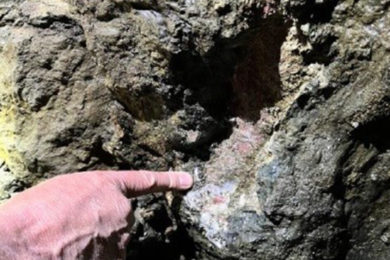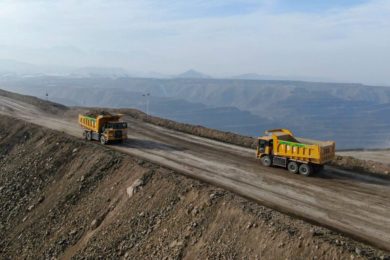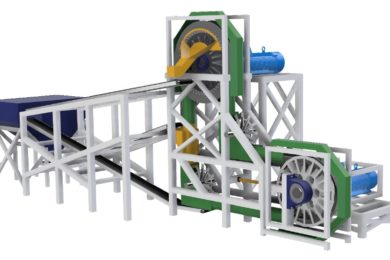 Greenland Minerals and Energy Ltd (GMEL) says it has made “a critical technical breakthrough on the Kvanefjeld multi‐element project in Greenland.” Kvanefjeld is underpinned by one of the world’s largest known JORC‐code compliant resources of rare earth elements and uranium. In early 2010, the company released an interim prefeasibility report outlining a base‐case development scenario that would see Kvanefjeld developed as a cost‐effective, long life operation. Since then, focused research and development has led to major technical breakthroughs in the area of mineral beneficiation that provide a clear path to an increasingly efficient and cost‐effective development scenario.
Greenland Minerals and Energy Ltd (GMEL) says it has made “a critical technical breakthrough on the Kvanefjeld multi‐element project in Greenland.” Kvanefjeld is underpinned by one of the world’s largest known JORC‐code compliant resources of rare earth elements and uranium. In early 2010, the company released an interim prefeasibility report outlining a base‐case development scenario that would see Kvanefjeld developed as a cost‐effective, long life operation. Since then, focused research and development has led to major technical breakthroughs in the area of mineral beneficiation that provide a clear path to an increasingly efficient and cost‐effective development scenario.
- Major advances in mineral beneficiation provide a means to simply and effectively transform the Kvanefjeld ores into a high‐grade, low‐mass mineral concentrate
- Test work demonstrates TREO grade increases of greater than ten times; a very high upgrade ratio within the specialty metals sector
- The method has now been successfully piloted under continuous operation to produce a bulk mineral concentrate. This concentrate is now being tested to establish the most favourable downstream leach solution chemistries
- Effective beneficiation allows for the major downsizing of hydrometallurgical leach circuits, and is anticipated to lead to significant reductions in overall capital and operating costs
- Importantly, these studies demonstrate that not only are the Kvanefjeld resources extensive, but the minerals are fundamentally amenable to concentration, allowing for efficient and cost‐effective REE and uranium extraction.
The company is now fast‐tracking test work to identify the most suitable leach chemistry for the mineral concentrate. The results of this testwork will be released over the coming months, along with further enhancements to the beneficiation circuit. The technical advances are in line with GMEL’s current focus of identifying and delivering the optimal development scenario for the Kvanefjeld multi‐element project.
GMEL has been advancing the Kvanefjeld project, located favourably in southern Greenland, since 2007. A large, outcropping multi‐element resource of REEs, uranium and zinc has been defined at Kvanefjeld, with attention now focused on delineating high‐grade satellite deposits at Zones 2 and 3. In parallel with resource development, the Company has been conducting comprehensive metallurgical and process development studies to establish the optimal way to process the Kvanefjeld resources. A base‐case flow sheet has been established, as outlined in the Interim Prefeasibility Report on Kvanefjeld, released in January 2010. The study clearly demonstrated that Kvanefjeld could be developed as a large‐scale, long‐life and cost effective producer of rare earth concentrates and uranium. The company has recently commenced environmental and social impact assessments on the Kvanefjeld project, following an extensive phase of stakeholder engagement in Greenland. Infrastructure studies are also well‐advanced.
Since the release of the interim prefeasibility report in early 2010 the company has made numerous technical advancements including increases in RE recovery, ore grades, the size of the resource estimate, and subsequent improvements in the grades in the mine schedule. However, the most important development has been the identification of a method to beneficiate the ore into a high‐grade, low‐mass fraction. The implications of this are highly significant.
Through a simple flotation step, Kvanefjeld ore is transformed into a much higher‐grade mineral concentrate that constitutes <15% of the original mass. This presents the opportunity to scale down the downstream leach circuits proportionally, reducing capital costs, and improving operational efficiency and costs. Test work has also indicated that a high‐grade zinc concentrate can be generated using flotation.
The resources at Kvanefjeld are hosted by an unusual rock‐type called lujavrite. GMEL conducts a research program at the Mineral Deposit Research Unit, UBC, Vancouver, which is devoted to understanding the minerals that make up the Kvanefjeld resource. Rare earths and uranium are predominantly hosted in unusual phosphate minerals that constitute < 10% of the mass (the economic minerals). The phosphate minerals include steenstrupine and vitusite. Sodium‐zirconium silicate minerals (Lovozerite group) host the residual REEs and uranium.
The comprehensive mineralogical understanding has allowed for a highly focused beneficiation test work program, conducted by GMEL in association with internationally‐recognised consultants. Through these studies the company has identified a flotation methodology that can very effectively concentrate the phosphate minerals. These minerals host the majority of REEs and uranium within the deposit. The phosphate‐group mineral concentrate features an approximately ten‐fold increase in TREO grades.
Test work has also demonstrated that a high‐grade zinc (sphalerite) concentrate can be recovered using flotation. Importantly, flotation is an industry proven beneficiation method with low technical risk.
The company has now successfully piloted the flotation circuit to produce a REE‐U rich mineral concentrate (phosphate group). A zinc (sphalerite) concentrate is removed in a simple step prior to the generation of the REE‐U concentrate. The flotation circuit was run for 15 hours continuously; with the primary aim of generating bulk mineral concentrates for hydro‐metallurgical leach studies. The ability to effectively concentrate the REE‐U bearing phosphate minerals into a small mass fraction represents a critically important breakthrough in establishing the optimal process flow‐sheet for the Kvanefjeld project.
Following these breakthroughs, GMEL believes that a flowsheet that is based on upfront, efficient beneficiation will likely be the optimal flow sheet for the Kvanefjeld project. Over the coming months as this flowsheet is advanced, it will be evaluated against the base‐case scenario that had already been extensively studied at a pre‐feasibility level. The base‐case represents an economically and technically robust scenario; however, it does not include efficient up‐front mineral beneficiation, and, therefore, requires the processing of larger volumes of lower‐grade feed. The ability to effectively beneficiate is anticipated to improve on the base‐case considerably.
The selection of the optimal flowsheet is slated for early 2012, which is in accordance with the broader development schedule for the Kvanefjeld project. The finalisation of the Kvanefjeld flowsheet will be immediately followed by detailed design work, with piloting of the entire final flowsheet scheduled to commence in the latter half of 2012.








